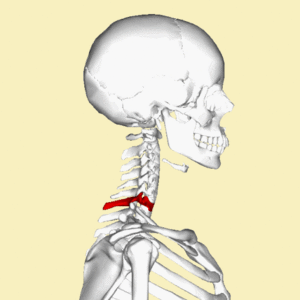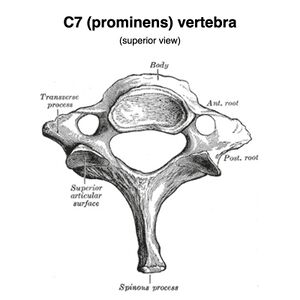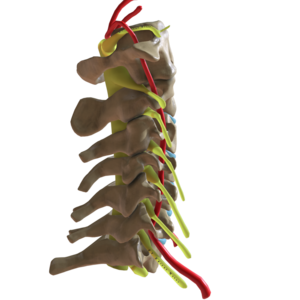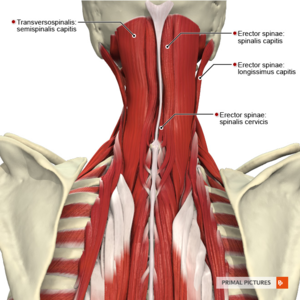Vertebra Prominens: Difference between revisions
No edit summary |
Kim Jackson (talk | contribs) m (Text replacement - "Brachial plexus" to "brachial plexus") |
||
| (12 intermediate revisions by 3 users not shown) | |||
| Line 6: | Line 6: | ||
== Introduction == | == Introduction == | ||
[[File:C7 animation (1).gif|right|frameless]] | |||
Vertebra prominens is the name of the seventh cervical vertebra. | |||
# The 7th [[Cervical Vertebrae|cervical vertebra]] (C7) is the largest and most inferior vertebra in the neck region. Unlike the other cervical vertebrae, the C7 has a large spinous process that protrudes posteriorly toward the [[skin]] at the back of the [[Cervical Anatomy|neck]]. | |||
# This spinous process can be easily seen and felt at the base of the neck, making it a prominent [[:Category:Anatomical Landmarks|landmark of the skeleton]] (giving the C7 the name vertebra prominens). | |||
# The C7 is located in the spinal column inferior to the 6th cervical (C6) vertebra and superior to the first thoracic (T1) <ref name=":0" />. | |||
Image 1: C7 animation gif | |||
== Features == | |||
[[File:Vertebra-prominens-grays-illustration.jpeg|right|frameless]] | |||
As the transitional vertebra between the cervical and thoracic regions, the C7 has some features of both the cervical and thoracic vertebrae. | |||
= | # Like the C3 through C6 vertebrae, C7 has a thicker area of bone called the '''Body''', located anterior to the vertebral foramen. The body of C7 supports the collective weight of the head and neck. | ||
# '''Lateral Facets,''' allow C7’s body to form joints with the C6 vertebra above it and the T1 below it. The facets surrounding the body provide both stability and flexibility to the neck. | |||
# Fibrocartilaginous [[Intervertebral disc|intervertabral discs]] above and below the C7’s body provide cushioning. The discs surrounding the body provide both stability and flexibility to the neck<ref name=":0">Inner body research [https://www.innerbody.com/anatomy/skeletal/c7-7th-cervical-vertebra C7] Available: https://www.innerbody.com/anatomy/skeletal/c7-7th-cervical-vertebra<nowiki/>(accessed 4.11.2021)</ref>. | |||
== Distinct Features == | |||
[[File:Cervical Spine Lateral View.png|right|frameless]] | |||
C7 possesses the standard cervical vertebral features but has some distinct features: | |||
* spinous process ends in a rounded tubercle and is not bifid | |||
* C7 transverse foramina are small, and do not transmit the [[Vertebral Artery|vertebral artery]] | |||
* C7 anterior tubercle is small, and is the site of attachment for [[Scalenus Minimus|scalenus minimus]] and suprapleural membrane | |||
* C8 nerve, which does not have an associated cervical vertebra, exits in the C7-[[Thoracic Vertebrae|T1 vertebral foramen]] below C7<ref name=":1" /> | |||
Image 3: Lateral View cervical spine | |||
== | == Attachments == | ||
[[File:Muscles of the cervical region intermediate muscles Primal.png|right|frameless]] | |||
Several bony processes extend from the vertebral arch and provide important muscle attachment sites for the muscles of the neck. | |||
# On both lateral sides of C7, the transverse processes provide insertion points for the [[Erector Spinae|erector spinae]] muscles that extend and flex the neck. | |||
# The spinous process extends from the posterior of the vertebral arch to provide connection points for the muscles that extend the neck, including the [[trapezius]] and [[Spinalis Cervicis|spinalis]] muscles. | |||
# The end of the [[Ligamentum nuchae|nuchal ligament]], which supports the muscles of the neck and connects the [[Occipital Bone|occipital]] bone of the [[skull]] to the C7 vertebra, attaches at the tip of the spinous process<ref name=":0" />. | |||
== Anomalies == | |||
# C7 may possess a [[Cervical Rib|cervical rib]] due to the anterior root of the transverse process having a large size and exists as a separate bone. These ribs are usually small, but may occasionally compress blood vessels (such as the subclavian artery or subclavian vein) or nerves in the [[Brachial Plexus|brachial plexus]], causing pain, numbness, tingling, and weakness in the upper limb, a condition known as [[Thoracic Outlet Syndrome (TOS)]]. | |||
# C7 foramen may transmit the grey ramus from the inferior cervical [[ganglion]] to the anterior ramus of C7 | |||
# Vertebral artery may enter at this level (usually it enters the cervical transverse foramen at C6)<ref name=":1">Radiopedia [https://radiopaedia.org/articles/c7-vertebra C7 Vertebra] Available:https://radiopaedia.org/articles/c7-vertebra (accessed 4.11.2021)</ref> | |||
== References == | == References == | ||
<references /> | <references /> | ||
[[Category:Anatomy]] | |||
[[Category:Bones]] | |||
[[Category:Cervical Spine - Bones]] | |||
[[Category:Anatomical Landmarks]] | |||
Latest revision as of 19:01, 8 March 2024
Original Editor - Rachael Lowe
Top Contributors - Lucinda hampton, Admin, Kim Jackson and WikiSysop
Introduction[edit | edit source]
Vertebra prominens is the name of the seventh cervical vertebra.
- The 7th cervical vertebra (C7) is the largest and most inferior vertebra in the neck region. Unlike the other cervical vertebrae, the C7 has a large spinous process that protrudes posteriorly toward the skin at the back of the neck.
- This spinous process can be easily seen and felt at the base of the neck, making it a prominent landmark of the skeleton (giving the C7 the name vertebra prominens).
- The C7 is located in the spinal column inferior to the 6th cervical (C6) vertebra and superior to the first thoracic (T1) [1].
Image 1: C7 animation gif
Features[edit | edit source]
As the transitional vertebra between the cervical and thoracic regions, the C7 has some features of both the cervical and thoracic vertebrae.
- Like the C3 through C6 vertebrae, C7 has a thicker area of bone called the Body, located anterior to the vertebral foramen. The body of C7 supports the collective weight of the head and neck.
- Lateral Facets, allow C7’s body to form joints with the C6 vertebra above it and the T1 below it. The facets surrounding the body provide both stability and flexibility to the neck.
- Fibrocartilaginous intervertabral discs above and below the C7’s body provide cushioning. The discs surrounding the body provide both stability and flexibility to the neck[1].
Distinct Features[edit | edit source]
C7 possesses the standard cervical vertebral features but has some distinct features:
- spinous process ends in a rounded tubercle and is not bifid
- C7 transverse foramina are small, and do not transmit the vertebral artery
- C7 anterior tubercle is small, and is the site of attachment for scalenus minimus and suprapleural membrane
- C8 nerve, which does not have an associated cervical vertebra, exits in the C7-T1 vertebral foramen below C7[2]
Image 3: Lateral View cervical spine
Attachments[edit | edit source]
Several bony processes extend from the vertebral arch and provide important muscle attachment sites for the muscles of the neck.
- On both lateral sides of C7, the transverse processes provide insertion points for the erector spinae muscles that extend and flex the neck.
- The spinous process extends from the posterior of the vertebral arch to provide connection points for the muscles that extend the neck, including the trapezius and spinalis muscles.
- The end of the nuchal ligament, which supports the muscles of the neck and connects the occipital bone of the skull to the C7 vertebra, attaches at the tip of the spinous process[1].
Anomalies[edit | edit source]
- C7 may possess a cervical rib due to the anterior root of the transverse process having a large size and exists as a separate bone. These ribs are usually small, but may occasionally compress blood vessels (such as the subclavian artery or subclavian vein) or nerves in the brachial plexus, causing pain, numbness, tingling, and weakness in the upper limb, a condition known as Thoracic Outlet Syndrome (TOS).
- C7 foramen may transmit the grey ramus from the inferior cervical ganglion to the anterior ramus of C7
- Vertebral artery may enter at this level (usually it enters the cervical transverse foramen at C6)[2]
References[edit | edit source]
- ↑ 1.0 1.1 1.2 Inner body research C7 Available: https://www.innerbody.com/anatomy/skeletal/c7-7th-cervical-vertebra(accessed 4.11.2021)
- ↑ 2.0 2.1 Radiopedia C7 Vertebra Available:https://radiopaedia.org/articles/c7-vertebra (accessed 4.11.2021)










